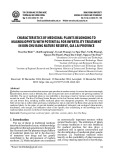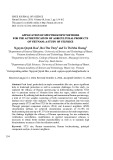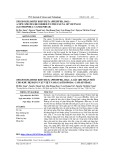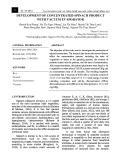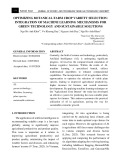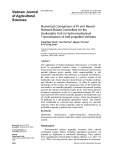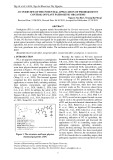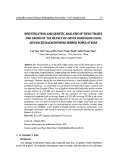
Effects of plant growth regulators and basal media on Atractylodes macrocephala Koidz.'s shoot multiplication*Nguyen Thanh Tai, Phan Thuy Quyen, Pham Thu Nhi, Pham Quang Thang and Le Thanh HungResearch and Development Center for High Technology Agriculture ABSTRACT Atractylodes macrocephala Koidz. belonging to the genus Atractylodes is a high-value medical plant with more than 79 phytochemical components. However, few studies about the miropropagation protocol of this species are conducted in Vietnam. The purpose of this study is to investigate the effects of some PGRs and basal media on Atractylodes macrocephala Koidz's in vitro shoot multiplication viewed as the most critical stage in the miropropagation protocol. In this study, stem nodes with dorminant shoots were cultured on different media after selecting an optimized medium from experiments supplemented with BA in combination with IBA with different concentrations. After four weeks of culture, the highest number of shoots on MS medium containing 1 mg/L BA in combination with 0.3 mg/L IBA was 2.18 shoots/explant. 1/2Interestingly, the optimized medium for AM's in vitro shoot proliferation was MS medium supplemented with 1 mg/L BA in combination with 0.3 mg/L IBA. The highest number of shoots reached at 14.5 shoots/explant being more than 4 times compared to the results of the previous studies. The result significantly contributes to the efficient micropropagation of Atractylodes macrocephala Koidz. for comercial production. Keywords: Atractylodes macrocephala Koidz., plant growth regulators, shoot multiplication Atractylodes macrocephala Koidz. is a valuable medicinal plant widely distributed in Southeast Asia, including China, Korea and Japan. Its rhizome called “Baizhu” in tradional herbal medicine contains more than 79 chemical compounds like sesquiterpenoids, triterpenoids, polyacetylenes, and flavonoids with a range of biological acvies [1]. Especially, volale oil such as atractylon and atractylodin accounts for about 1.4% [2]. The role of Atractylodes macrocephala (AM) in improving gastrointesnal funcon is invesgated thanks to the accumulaon of abundant polysaccharides and atractylenolides in AM rhizomes [3]. In addion, other various pharmacological acvies including an-tumor acvity, immunomodulatory effects, an-inflammatory acvity and an-oxidave acvity are assessed in numerous studies [1, 4, 5]. In Vietnam, AM rhizomes are mainly imported from China, and culvang this species is partly limited since Atractylodes macrocephala only grows rapidly in the cool climate regions. As a result, the demand for commercial producon of AM is enormously increasing.Praccally, the AM's convenonal propagaon is rather low because of the poor germinaon of the seeds. Therefore, the establishment of an in vitro micropropagaon protocol is viewed as an efficient approach to propagate the rapid mass propagaon of Atractylodes macrocephala variees for commercial producon. Although there are some studies conducted all over the world [6 - 8], few studies are carried out in Vietnam, except for the study of Nguyen Manh Dung [9]. However, the above studies focus on the influences of PGRs on AM's shoot mulplicaon in only MS (Murashige & Skoog) medium. Other basal media such as Gamborg's B5, VW (Vacin and Went) and SH (Schenk & Hildebrandt) have not invesgated yet so far. Chemical ingredients in basal media play a crical role in the development of cells in plant ssue culture, so selecng an adequate medium in each stage of in vitro micropropagaon protocol is absolutely necessary [10]. Following the above 95Hong Bang Internaonal University Journal of ScienceISSN: 2615 - 9686Hong Bang Internaonal University Journal of Science - Vol.4 - June 2023: 95-100DOI: hps://doi.org/10.59294/HIUJS.VOL.4.2023.391Corresponding Author: Nguyen Thanh TaiEmail: thanhtai2407@gmail.com1. INTRODUCTION

96Hong Bang Internaonal University Journal of ScienceISSN: 2615 - 9686Hong Bang Internaonal University Journal of Science - Vol.4 - June 2023: 95-100reasons, this study is carried out to explore the influences of PGRs and basal media on Atractylodes macrocephala's shoot proliferaon to increase a large number of in vitro shoots for the in vitro micropropagaon protocol. 2. MATERIALS AND METHODS Plant materials Explant sourceExplants of this study are 3-month-old seedlings bought from Xuyen Viet Corporaon Company at Lao Cai Province.Explant sterilizaonStem nodes in length 2 cm excised from the above seedlings were sterilized with comercial bleach containing 5% sodium hypochlorite diluted in water in 1:1(v/v) within 5 minutes in the first step. And then, these explants were connuously treated in comercial bleach containing 5% sodium hypochlorite diluted in water in 1:5 (v/v) in 10 minutes before rising with sterilized water in 6 mes. Shoot iniaon medium The above asepc nodes were cultured in MS medium supplemented with 0.5 mg/L 6-benzylaminopurine) (BA) (30 g/L sucrose, and 8 g/L agar (Figure 1). Plant material
Nodal segments with the length from 2 to 3 cm are excised from the in vitro shoots aer 4 weeks of culture.Cultural condions All the explants were incubated in the growth room under condions, including temperature 25 0± 2C, relave humidity 60 ± 5%, and a 12-h photoperiod under a photosynthec photon flux 21density of 40 ± 5 μmol.m s.Methods Invesgaon of the effects of 6-benzylaminopurine (BA) in combinaon with Indole-3-Butyric Acid (IBA) on in vitro shoot mulplicaon of Atractylodes macrocephala Koidz.4-week-old nodal segments containing dorminant shoots were cultured in MS medium supple-mented with BA at different concentraons (0.5; 1; 1.5; 2 mg/L) in combinaon with IBA at two different concentraons (0.3 and 0,5 mg/L), 30 g/L sucrose, and 8 g/L agar. The experiment design was a completely randomized design (CRD) including 9 treatments; one factor with 3 replicaons, each repeated 3 flasks, 3 explants/flask. The number of shoots per explant was recorded aer 4 weeks of culture. Invesgaon of effects of basal media on in vitro shoot mulplicaon of Atractylodes macrocephala Koidz.Nodal segments containing dorminant shoots excised from single shoots isolated from the shoots in the above experiment aer 8 weeks of culture (Figure 2). These explants were cultured in different Figure 1. The shoots developing from stem nodes aer 4 weeks of culture

97Hong Bang Internaonal University Journal of ScienceISSN: 2615 - 9686Hong Bang Internaonal University Journal of Science - Vol.4 - June 2023: 95-1003. RESULTS AND DISCUSSION Effects of BA in combinaon with IBA on in vitro shoot mulplicaon of Atractylodes macrocephala Koidz.In the micropropagaon protocol for medical plants, cytokinins are used alone or in combinaon with auxins to induce dorminant shoots through regulang in plants' development and growth [10]. In this experiment, BA are employed in combinaon with IBA with different concentraons. Aer four weeks of culture, there are differences from the number of shoots recorded in treatments (Table 1).1/2basal media, including MS (Musharige Skoog), MS 1/2 (a half of all nutrients), MS(a half of macro-nutrients, VW (Vacin and Went), and Gamborg's B5 supplemented with the opmized concentraon of BA in combinaon with IBA from the above experiment, 30 g/L sucrose, and 8 g/Lagar.The experiment design was a completely randomized design (CRD) including 5 treatments; one factor with 3 replicaons, each repeated 3 flasks, 5 explants/flask. The number of shoots per explant was recorded aer 4 weeks of culture. Figure 2. (A) The shoots aer 8 weeks of culture; (B) A nodal segment excised from a single shootTable 1. AM's in vitro shoot mulplicaon aer 4 weeks of culture in MS medium supplemented with different PGRs
Treatments
Plant growth regulators (PGRs)
Number of shoots
BA (mg/L)
IBA (mg/L)
Control
0
0
1e
NT1
0.5
0.3
1.44cd
NT2
1
0.3
2.18a
NT3
1.5
0.3
1.63bc
NT4
2
0.3
1.22de
NT5
0.5
0.5
1.22de
NT6
1
0.5
1.71b
NT7
1.5
0.5
1.44cd
NT8
2
0.5
1.33d
CV%
8.4
In the same columns, different leers indicate stascally significant difference (p ≤ 0.05); Significant differences of the treatments using Duncan's mulple range tests; Control: cultured medium without plant growth regulators Stascal analysis All data were tested using a one-way analysis of variance (ANOVA) by SAS version 9.2.

98Hong Bang Internaonal University Journal of ScienceISSN: 2615 - 9686Hong Bang Internaonal University Journal of Science - Vol.4 - June 2023: 95-100Effects of basal media on in vitro shoot mulplicaon of Atractylodes macrocephala Koidz.Basal media provide essenal nutrients for the growth and development of cells during the period of in vitro culture [10]. Aer four weeks of culture, all explants differently created shoots in each treatment (Table 2). According to Table 1, the highest number of shoots (2.18 shoots/explant) was recorded in MS medium supplemented with 1 mg/L BA in combinaon with 0.3 mg/L IBA. When BA concentraons were higher, the number of shoots decreased. Specifically, BA concentraons in combinaon 0.3 mg/L IBA went from 1 up to 2 mg/L. As a result, the number of shoots went down from 2.18 to 1.22 shoots/explant. Similarly, whereas BA concen-traons in combinaon 0.5 mg/L IBA rose from 1 to 2 mg/L, the number of shoots decreased from 1.71 to 1.33 shoots/explant.In the previous studies, MS medium was supplemented BA in combinaon with NAA rather than with IBA [6 - 7]. Parcularly, in the study of Chen et al., MS medium with 1 was supplementedmg/L BA in combinaon with 0.2 mg/L NAA [6]. The highest number of shoots is 4.55 shoots/explant being higher than the shoot numbers in this study. It can be seen that different auxins in combinaon with the same cytokinin can differently affect the development of shoots.Moreover, the results of the study showed that the rate of nodal segments developing shoots was 100 percent. The shoots had two leaves or more and the formaon of roots in all treatments (Figure 3). This outcome was similar to the study of Liang et al. as well as Tao et al. in terms of the rate of nodal segments developing shoots when culturing the explants of Atractylodes macrocephala Koidz. in the medium containing the plant growth re-gulators [7 - 8]. Figure 3. The shoot proliferaon of Atractylodes macrocephala Koidz. aer four weeks of culture
Treatments
Basal media
Number of shoots
M1
MS
8.67d
M2
1/2MS
14.09a
M3
MS1/2
10.4bc
M4
VW
9.67c
M5
B5
10.67b
CV%
4.6
Table 2. The number of shoots of Atractylodes macrocephala Koidz. aer 4 weeks of culture in different basal media In the same columns, different leers indicate stascally significant difference (p ≤ 0.05); Significant differences of the treatments using LSD's mulple range tests

99Hong Bang Internaonal University Journal of ScienceISSN: 2615 - 9686Hong Bang Internaonal University Journal of Science - Vol.4 - June 2023: 95-100Numerous studies have been conducted to propagate Atractylodes macrocephala variees from different parts of the world. However, MS medium had been used in all previous studies, with different numbers of shoots produced. In the study of Chen et al., the highest number of shoots (4.55 shoots/explant) was produced in MS medium supplemented with 1 mg/L BA and 0.2 mg/L NAA [6]. In addion, the number of shoots recorded in MS medium supplemented with NAA in combinaon with TDZ is 5.61 shoots/explant [8]. According to the study of Nguyen Manh Dung, MS medium supplemented with 2 mg/L BA in combinaon with 1.5 mg/L Kinen is recorded the highest number of shoots (3.24 shoots/explant) [9]. It can be seen that the number of shoots in this study is much higher than in the previous studies when culturing on ½ MS medium supplemented 1 mg/L BA in combinaon with 0.3 mg/L IBA. This leads to the efficient micropropagaon protocol of Atractylodes macrocephala Koidz. for producon. The result of the study shows that the basal medium plays a great importance in propagang the shoots. A suitable medium must be chosen at every stage of the in vitro micropropagaon technique depending on the propagated species rather than using the same basal medium for all the plants. 4. CONCLUSION The opmized medium for shoot proliferaon of Atractylodes macrocephala Koidz. is ½ MS medium supplemented with 1 mg/L BA in combinaon with 0.3 mg/L IBA with shoot number reaching at 14.09 shoots/explant. [1] B. Zhu, Zhang, W. J. Hua, L. W. Cheng, and P. L. Qin. “The tradional uses, phytochemistry, and pharmacology of Atractylodes macrocephala Koidz: a review.” Journal of Ethnopharmacology, Vol. 226, pp. 143-167, 2018. DOI: 10.1016/j.jep.2018.08.023[2] S. Gu, L. Li, H. Huang, B. Wang, and T. Zhang. "Antumor, anviral, and an-inflammatory efficacy of essenal oils from Atractylodes macrocephala Koidz. Produced with different processing methods." Molecules, Vol. 24, No. 16, REFERENCESThe Table 2 showed that the highest number of 1/2shoots was 14.09 shoots/explant in MS medium supplemented with 1 mg/L BA in combinaon with 0.3 mg/L IBA in comparison with the other media such as MS, VW, and B5. While the number of shoots reaching 8.67 shoots/explant in this experiment was higher than the number of shoots in the previous experiment at 2,18 shoots/explant in the medium MS supplemented with 1 mg/L BA in combinaon with 0.3 mg/L IBA. There was a difference between the age of the explants in this experiment (nodal segment aer 8 weeks of culture) and in the previous experiment (nodal segments aer 4 weeks of culture). This led to the larger segments containing many dormant shoots (Figure 4). Figure 4. The shoot proliferaon of Atractylodes macrocephala Koidz. aer four weeks of culture

